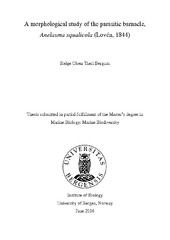| dc.contributor.author | Bergum, Helge Olsen Theil | eng |
| dc.date.accessioned | 2018-04-26T08:30:14Z | |
| dc.date.available | 2018-04-26T08:30:14Z | |
| dc.date.issued | 2016-06-30 | eng |
| dc.date.submitted | 2016-06-30 | eng |
| dc.identifier.uri | https://hdl.handle.net/1956/17659 | |
| dc.description.abstract | Objectives and Summary The pedunculate barnacle, Anelasma squalicola, is found parasitizing various squaloid sharks of the family Etmopteridae. Its peduncle has been modified to bury in the flesh of its host, and has replaced its cirri as a feeding device. It is however still in possession of its cirri, albeit reduced, and digestive tract, both believed to be of a vestigial nature. Due to the curious appearance of Anelasma it has been of great interest to scientists since its first description in the 18th century. Despite this it has rarely been studied, due to a low frequency and a seemingly patch distribution, and many details of its morphology and adaptations to a parasitic mode of life remains unclear. By employing new methodologies including SEM, histology, micro-CT scanning 3D-reconstruction, this study aims to investigate and clarify Anelasmas morphology and adaptations to a parasitic way of life. Through micro-CT scanning and 3D-reconstruction the intricacy of the root system of Anelasma has been revealed, showing an extensively branching system, penetrating deep into the tissue of its host. Histology reveals that the cuticle of the peduncle and the roots is thinning with distance from the mantle, and in the roots the exocuticle has been entirely reduced. It can be seen covering the tips of the roots to the very end. Its reproductive system is very well developed and takes up most of the space in the peduncle and thorax. The cement glands are numerous, and can be seen throughout the lower part of the mantle and in the waist, they have been seen emptying into the lacunae and I hypothesize that their function in Anelasma is to aid in the digestion of or nutrient uptake from its host. The lacunar system has also been seen in great detail, originating from the great central lacunae running axially through the peduncle and branching out to envelop the ovarian tubes and out into the tips of the roots. It is likely that the function of the lacunae is to transport absorbed nutrients throughout the body of Anelasma. All in all, Anelasma seems beautifully adapted to a life as a parasite. | en_US |
| dc.format.extent | 39802668 bytes | eng |
| dc.format.mimetype | application/pdf | eng |
| dc.language.iso | eng | eng |
| dc.publisher | The University of Bergen | en_US |
| dc.subject | Marine parasitter | NOB |
| dc.subject | Anelasma, squalicola, parasite, barnacle, shark, Etmopterus, spinax, A. squalicola, E. spinax, pedunculate, peduncle | eng |
| dc.subject | Fiskeparasitter | nob |
| dc.subject | Morfologi | nob |
| dc.subject | Rankefotinger | nob |
| dc.subject | Haier | nob |
| dc.title | A morphological study of the parasitic barnacle, Anelasma squalicola (Lovén, 1844) | en_US |
| dc.type | Master thesis | |
| dc.rights.holder | Copyright the Author. All rights reserved | en_US |
| dc.description.degree | Master i Biologi | en_US |
| dc.description.localcode | MAMN-BIO | |
| dc.description.localcode | BIO399 | |
| dc.subject.realfagstermer | https://data.ub.uio.no/realfagstermer/c004061 | |
| dc.subject.realfagstermer | https://data.ub.uio.no/realfagstermer/c010245 | |
| dc.subject.realfagstermer | https://data.ub.uio.no/realfagstermer/c003776 | |
| dc.subject.realfagstermer | https://data.ub.uio.no/realfagstermer/c008753 | |
| dc.subject.realfagstermer | https://data.ub.uio.no/realfagstermer/c009851 | |
| dc.subject.nus | 751999 | eng |
| fs.subjectcode | BIO399 | |
